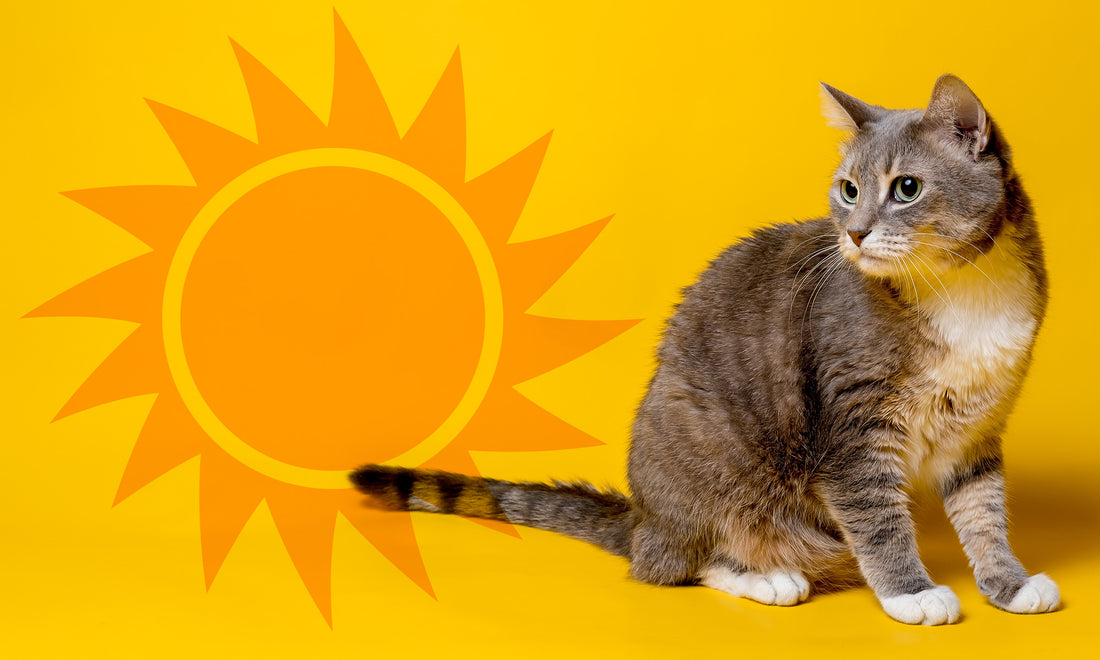
How to Protect Your Cat From the Summer Heat
What You Can Do to Keep Your Cat Safe During the Summer Heat
 Even though cats were originally roaming the desert, it doesn’t mean they can withstand scorching temperatures regularly — or ever, really. Similar to humans, your fur babies shouldn’t be left in the heat without having access to ice-cold water or a cool, shady spot (read: a spot to plop down right in front of the A/C). No matter the weather outside, you should always keep your cat’s body temperature in mind, especially since cats tend to find themselves in very precarious situations (think: hiding in the cabinet below your TV).When the summer heat hits, it’s especially important to watch out for telltale signs of heatstroke and give your cat precisely what it needs to cool down, like a cool bath and a big bowl of ice water. But there’s a lot more to it than just that. Here, we’ve broken down everything you need to know about how hot temperatures affect your cat’s health. Plus, what you can do to protect your fur baby on the hottest days of the year and beyond.
Even though cats were originally roaming the desert, it doesn’t mean they can withstand scorching temperatures regularly — or ever, really. Similar to humans, your fur babies shouldn’t be left in the heat without having access to ice-cold water or a cool, shady spot (read: a spot to plop down right in front of the A/C). No matter the weather outside, you should always keep your cat’s body temperature in mind, especially since cats tend to find themselves in very precarious situations (think: hiding in the cabinet below your TV).When the summer heat hits, it’s especially important to watch out for telltale signs of heatstroke and give your cat precisely what it needs to cool down, like a cool bath and a big bowl of ice water. But there’s a lot more to it than just that. Here, we’ve broken down everything you need to know about how hot temperatures affect your cat’s health. Plus, what you can do to protect your fur baby on the hottest days of the year and beyond.
How to Tell If Your Cat Is Too Hot
 Your cat’s health is an indicator of its overall temperature. While your fur baby won’t show the same symptoms as humans when it’s overheating (no sweat or goosebumps here), there are lots of warning signs to look out for. Initially, you may notice the following behaviors:
Your cat’s health is an indicator of its overall temperature. While your fur baby won’t show the same symptoms as humans when it’s overheating (no sweat or goosebumps here), there are lots of warning signs to look out for. Initially, you may notice the following behaviors:
- Restless Behavior: As their body temperature increases, your cat may become restless until it finds a spot to cool down. You may notice that they are circling the room or hiding away from the sun.
- Sweaty Feet: Although their body doesn’t sweat nearly as much like humans, cat’s feet may be indicators of their rising body temperature. If their feet feel cool and moist to the touch, chances are, they’re getting too hot.
- Excessive Grooming: Since they may feel like their body is out of control, cats will rely on what they know best — how to groom themselves! — to keep cool.
If the initial behaviors aren’t addressed, you may pick up on more severe symptoms of overheating, including:
- Breathing Rapidly/Panting: Your dog may pant every now and again, but cats rarely do. It is typically a sign of emergency in cats, whether it’s related to overheating or another serious illness. Take your cat to the vet immediately to rule out anything serious.
- Drooling or Salivating: If they’re already panting, look out for any excessive drool. While this is another normal behavior for dogs, it’s extremely rare in felines.
- Lethargy: Yes, cats do sleep upwards of 16 hours a day, but they still should have the energy to zoom around when they’re awake. Any cat who seems unusually tired, weak or uninterested in food or play may be overheating.
- Vomiting and diarrhea: As a general rule, always consult your vet if you suspect that your cat is vomiting or experiencing diarrhea from a heat-related illness.
- Trembling and General Unsteadiness: Just like humans, cats experience the shakes when their body temperature skyrockets. Keep an eye on them to see if they seem wobbly when they walk or exhibit any unusual behaviors.
- Red Gums: If your cat lets you get close enough, examine their gums to see if they are bright red in color, a clear indicator that they’re overheating.
- High Body Temperature: This one may seem like a given, but taking your cat’s temperature is the best way to tell if they’re too hot or not. Using your pet thermometer, check to see if your cat’s temperature falls above the normal range (100.5 to 102.5℉). Anything above 105℉ indicates heatstroke, and anything above 109℉ is an emergency.
How to Protect Your Cat from Hot Weather
 You never want to get to a point where your cat is struggling due to the heat. While some things may be out of your control, there are many ways that you can ensure that your cat stays nice and cool even on the hottest summer days. Always make sure your cat has plenty of shade and reserve a spot in your house for your cat to cool down, whether it’s right by the A/C or in a room with the blinds or curtains drawn. Keep fresh water out in the open and add a few ice cubes on sweltering days, so they can lick them to keep cool. When your cat is outside of your house, the same rules should apply. Always have fresh water available for them to drink, whether they’re in the car with you or exploring outside. When the outside temperature picks up, try to keep your cat away from greenhouses, sheds, garages and other spaces that trap heat. Protecting your cat may also mean that you have to adjust your playtime schedule. If you usually play with your cat during the middle of the day, push it back to nighttime to ensure that they can jump, run and chase their toys around without getting too hot. This also allows them to conserve their energy throughout the day, so they can really let it all out when the sun goes down.
You never want to get to a point where your cat is struggling due to the heat. While some things may be out of your control, there are many ways that you can ensure that your cat stays nice and cool even on the hottest summer days. Always make sure your cat has plenty of shade and reserve a spot in your house for your cat to cool down, whether it’s right by the A/C or in a room with the blinds or curtains drawn. Keep fresh water out in the open and add a few ice cubes on sweltering days, so they can lick them to keep cool. When your cat is outside of your house, the same rules should apply. Always have fresh water available for them to drink, whether they’re in the car with you or exploring outside. When the outside temperature picks up, try to keep your cat away from greenhouses, sheds, garages and other spaces that trap heat. Protecting your cat may also mean that you have to adjust your playtime schedule. If you usually play with your cat during the middle of the day, push it back to nighttime to ensure that they can jump, run and chase their toys around without getting too hot. This also allows them to conserve their energy throughout the day, so they can really let it all out when the sun goes down.
How to Cool Your Cat Down If They’re Too Hot
 Try as you might, there’s still a risk that your cat may trap itself in a tight corner on a hot day and overheat. Or weasel its way into the shed with no water in sight. When the worst-case scenario happens, follow these tips to help your cat cool down — literally:
Try as you might, there’s still a risk that your cat may trap itself in a tight corner on a hot day and overheat. Or weasel its way into the shed with no water in sight. When the worst-case scenario happens, follow these tips to help your cat cool down — literally:
- If your cat is showing the initial signs of heat distress but no serious symptoms: Bring your cat to the coolest spot in the house and encourage them to drink as much water as possible.
- If your cat is still conscious but showing any of the symptoms listed above: Soak your cat in cool (not ice cold) water and let them drink as much water as possible. Once they’re fully hydrated, hop in the car and head straight to the vet.
- If your cat is found unconscious in a dangerously hot environment: Soak your cat in cool water, avoiding the mouth and nose altogether. Stick a bag of ice or frozen veggies between their legs and head straight to the vet for a complete examination.
In any stage of heat stroke, it’s recommended that you bring your cat to the vet for proper care. Depending on the severity of their illness, the vet may give your cat cool fluids through an IV in addition to getting them to drink ice-cold water. Throughout their visit, the vet will continue to monitor their temperature to not dip too much and pose the risk of hypothermia. The vet won’t release your cat until their body temperature has stabilized and all of their organs are in solid working order.
Take Control of Your Cat’s Health
At Skoon, it’s no secret we love cats. So much so, we want to provide cat owners (like you!) with the best advice available. In addition to our beloved diatom pebble kitty litter that is dust and odor-free, we also offer probiotics to help your cat’s digestive system.
